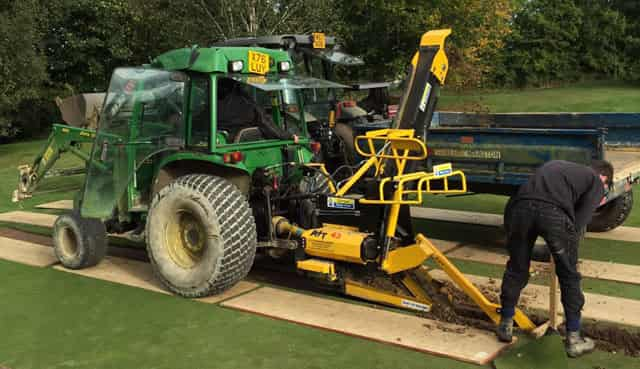To get the best out of your golf course it is essential to have proper drainage in place to manage excess water and runoff. Here’s everything you need to know.

The fundamentals of golf-course drainage
Golfers now have higher course conditioning expectations than ever, expecting to be able to play on quality grass come rain or shine. Golf courses don’t hesitate to spend thousands on irrigation systems to keep their greens watered during the summer months, and yet many fail to take into consideration incorporating proper drainage.
Poor drainage on a golf course can directly impact play in several ways;
- It can cause playing conditions to be inconsistent, ruining the enjoyment for customers and members.
- It can lead to wet, unplayable areas that require additional maintenance and downtime to revive.
- It can lead to course closures after extreme weather, which can impact revenue and customer satisfaction.
In short, inadequate drainage on a golf course makes it nearly impossible for groundsmen to provide a consistent quality playing surface, impacting the quality of the course, customer satisfaction and revenues.
Causes of poor drainage
Many factors can contribute to drainage problems including the type of soil on which the course is built, the topography of the course, proximity to the water table, and the severity of the wet weather conditions it is subjected to.
The soil
Soils that contain high proportions of silt and clay are notoriously slow to drain. This, combined with compaction in heavily played areas, can stop natural drainage.
The topography of the course
Slopes and hillsides direct surface and subterranean water into the lower areas below, which, if they do not have proper drainage, can turn wet and boggy.
Proximity to the water table
High water tables, such as those near water obstacles such as lakes, rivers, or ponds, become a problem when they reach between 12 and 16 inches of the surface. At this point, the surrounding area can become chronically waterlogged.
Wet weather conditions
Most golf courses can handle a light rain, but for courses in notoriously wet areas, or locations that see short bursts of exceptionally heavy rain, the ground will usually require help with drainage to sustain a consistent quality of play.

Improving drainage on the golf course
The good news is that although drainage problems can spell disaster for a golf course, they can be fixed by investing in drainage improvement works. Whether the course already has existing drainage in place that requires upgrading and maintenance or is in need of entirely new drainage infrastructure, drainage is an investment for the future of the course.
Ways to improve drainage
There are a number of ways to improve the drainage of a golf course, from basic landscaping and aeration of the soil to improving surface drainage and creating subterranean drainage channels that use pumps and siphons. Here are some of the most popular.
Lowering water obstacles
The easiest way to combat a high water table caused by ponds or man-made water features is to lower water obstacles so that they are deeper than 16 inches below ground level. In cases where water obstacles cannot be lowered, increasing ground level can also help.
Improving surface drainage
Surface drainage refers to the drainage of water directly off the playing surface and is one of the most economical forms of drainage to improve. Good surface drainage allows courses with low permeability to continue to perform well even in moderately wet conditions by directing water off of the playing surface. Surface drainage can be improved with clever landscaping the use of open trenches and ditches for water to run away through.
Improving subsurface drainage
For areas where the surface drainage can not be easily improved, subsurface drainage can provide an alternative solution. The most common form of subsurface drainage involves inlets placed at the lowest part of course, which then lead to collector pipes that are surrounded by sand to move the water away. As well as pipes, sand-slit drainage systems can also be used in areas where the soil is clay-laden or compacted, providing sand-filled trenches across slopes helps to facilitate water flow.
Conducting drainage works with AFT Trenchers
Most drainage work that needs to be conducted on a golf course requires the use of specialist trencher machinery to dig uniform trenches that can either be left open for surface run-off or closed over subsurface pipework and sand. Here at AFT Trenchers, we supply both tractor-mounted and PTO driven trenchers for drainage and irrigation projects all over the world. Designed to dig trenches at a variety of widths and depths, our trenchers can help you to reduce downtime on the course and to create intricate drainage systems. To find out more about our trenching machinery and how it can help you to improve the drainage of your golf course, get in touch today on +44 (0) 1787 311811 or by emailing us at [email protected].
 English
English Français
Français Deutsch
Deutsch español
español Italiano
Italiano 日本語
日本語 Eλληνικά
Eλληνικά русский
русский